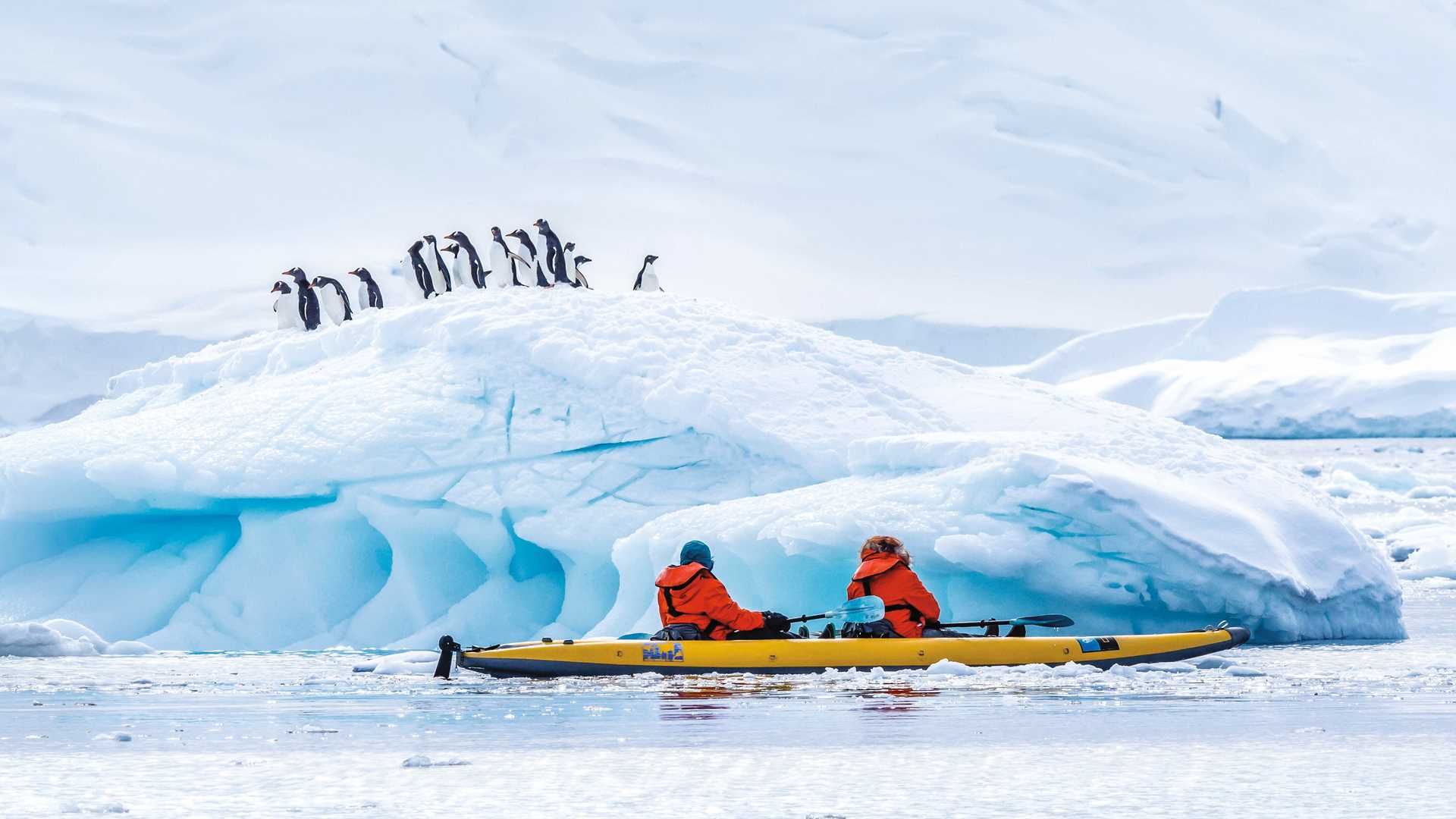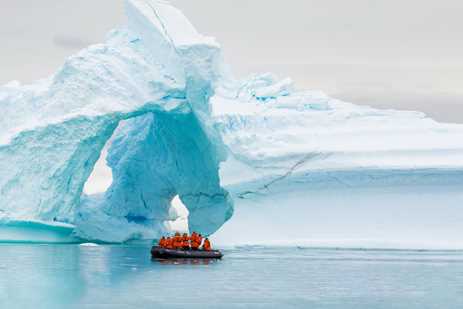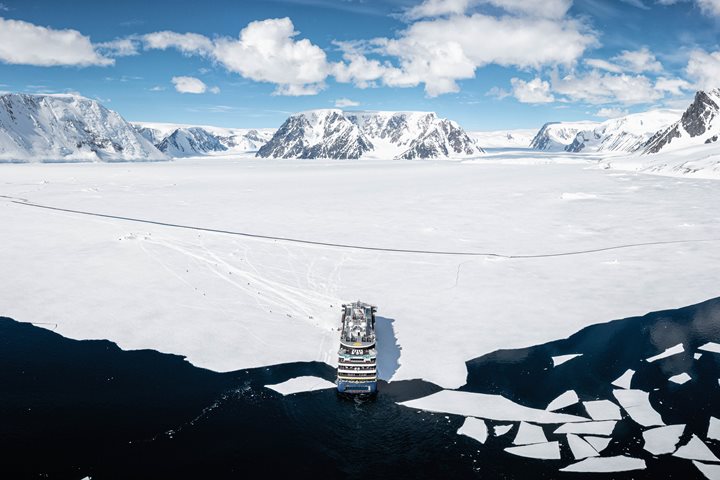Get Inspired By Photos, Videos, Webinars, Stories, And Exclusive Offers. Sign Up
As a wildlife photographer, Michael S. Nolan initially went to Antarctica for the whales, penguins and seals, but it was the landscape that kept him coming back more than 50 times. “It is a place that’s almost impossible to describe or even capture photographically,” he says. “It’s so immense, so untrammeled, so unspoiled, all those superlatives, they just fall short of describing it.” And it’s especially dazzling in the early season. “I love it always, but the early season is extra special,” he recalls. “It’s exactly what you think Antarctica should be. Everything is so pristine and snow-covered. It’s also the best time to get underwater shots—the water is crystal clear before the big plankton blooms that happen later on.” Here, Nolan shared some of his favorite shots from early season expeditions, and his expert polar photo tips. —As told to Lauren A. Greene
BROWSE ANTARCTICA ITINERARIES >
Set the Scene
This is a great example of an establishing shot—it really sets the story, tells you where you are, what time of year it is, and where the story is going. As with all action shots you want a pretty fast shutter speed to freeze that humpback and make sure every drop of water is crystal clear. This was taken at 1/1600th of a second. I was also on motor drive or continuous advance so my camera was taking multiple, rapid-fire images all at once. Then I was able to pick the best image where the humpback was perfectly positioned. Once they start, humpbacks sometimes repeat this behavior over and over. But the key is to have your camera at the ready at all times so you don’t have to run back to your cabin and miss out on a shot like this.
Create a Sense of Place
Antarctica is so huge, so covered in ice. This shot really helps provide a sense of scale. You know how big a ship is, how big people are so by including them here it gives the viewer an idea of how massive that iceberg really is and how expansive that ocean is. Another key thing this image does is inject a splash of color into this monochrome world. Antarctica is blue, black and white. There are not a lot of opportunities for color, even the animals are all black, white or gray. I love that pop of red from all the jackets. Lastly, I love to capture sunbeams. Those long rays add a dramatic element to the whole scene. To get that sunburst effect, you'll want to use higher aperture numbers: F11, F16 or F22.
Wake Up for the Golden Hour
This was taken just before midnight in the Weddell Sea which is famous for huge tabular icebergs. The biggest thing about getting a shot like this is knowing if something special is going to happen, like a full moon or a sea of icebergs. The next thing is then dragging yourself out of bed to be there for the Golden Hour. Unfortunately for us, those magic times of day, sunset and sunrise, are usually in the middle of the night in Antarctica! But that’s the great advantage of being on our ships. If our expedition leaders see there is a spectacular photo op, they’ll gently rouse everyone with a ship-wide announcement. So, you can roll out of bed, throw on your parka and be on the deck with your camera in no time flat. Our Captains will even position the ship for the optimal composition and then wait until everyone has the opportunity to shoot it.
Find the Details Within the Detail
Sometimes the most powerful image is a simple detail shot—a single animal or a single part of the animal. Having that wide-angle establishing shot is great, but then you want to fill in the details and bring your viewer to a very specific point. Instead of just taking one face shot and walking away, wait for the animal to give you just a bit more—the little details within the detail. In this case, a chinstrap penguin chick showed off its bristled tongue which really makes the shot. Don’t forget to choose a clean background so your subject really pops. That negative space is every bit as important as the subject so always check the edges of your frame for any distractions like a protruding rock. If necessary, move lower, higher, left or right to clear that background.
Look for Unique Perspectives
As a photographer you have to challenge yourself to come up with unique perspectives. There are a zillion ways you could shoot an iceberg. What I love about this is that it’s half above and half below the water which creates something pretty unique. And today it’s fairly easy to get underwater images—there are Go Pros; Canon, Nikon and Olympus all make underwater-dedicated cameras; or you can put your camera or your iPhone in a protective waterproof case. It’s as simple as positioning your camera half under and half above the water. The key is to know where the water is coming across. I don’t like flat water. I love the curvature of this shot so I actually pushed the camera a bit through the water. Just make sure your camera is attached to a lanyard or a waterproof selfie stick so you don’t lose it to the bottom of the ocean!
Get Eye Level with Wildlife
One of the most important things to me in photography is your perspective and trying to get on eye level or close to eye level to an animal. This is where the Zodiac cruises are incredibly valuable to a photographer. If this image had been taken from the bow of the ship looking down it wouldn’t be anywhere near as impactful. People often want to stand up in Zodiacs, but I always encourage them to stay as low as possible—even get on your knees if you can and position the camera just above the pontoon. This was shot at 1/1000th of a second to freeze that motion. You also want to opt for a zoom range where you can frame the shot to include the entire tail and all the birds.
Capture Wonder and Awe
I have been on Antarctica expeditions with tens of thousands of people. One of the universal themes I see in adults is a return to childhood wonder. Antarctica is so vast and so magical, and I think a great way to convey that amazingness is to literally capture your shipmates doing fun activities. All those people around you make excellent subjects—they bring color to the picture, they bring a sense of life, and they allow the viewer to feel like they’re actually there experiencing that same overwhelming awe. If you’re shooting snow on automatic, an important thing to know is that your camera is going to try to underexpose the image and make it too dark. You need to trick your camera by overexposing the shot. And that’s a big part of what we teach on the ship—how to control your individual phone or camera to get proper exposures in the snow.








